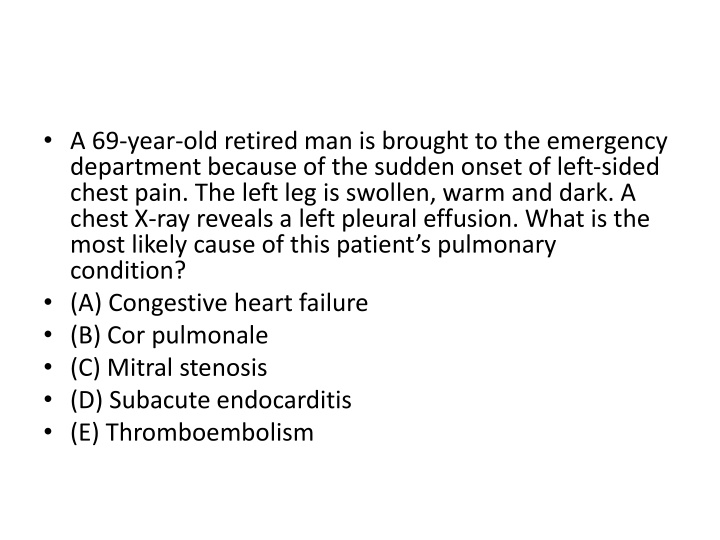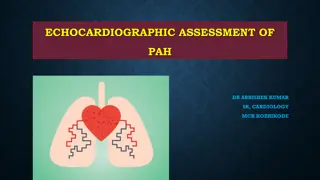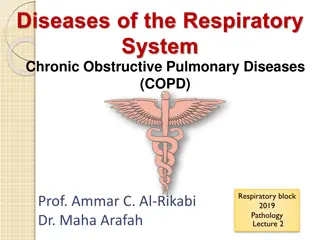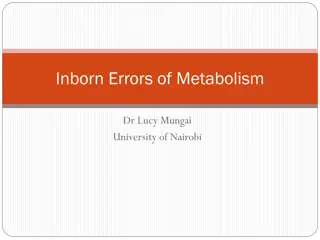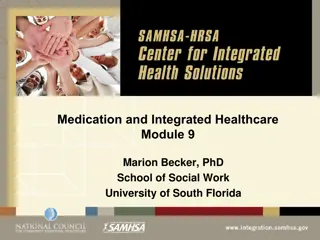Pulmonary Conditions and Hemodynamic Disorders: Clinical Cases
A 69-year-old man with chest pain and pleural effusion presents with thromboembolism; a 22-year-old worker with fractures develops shock due to fat embolism; a postpartum woman dies from amniotic fluid embolism. The cases illustrate conditions like pulmonary embolism, fat embolism, and amniotic fluid embolism, highlighting their clinical presentations and mechanisms.
Download Presentation

Please find below an Image/Link to download the presentation.
The content on the website is provided AS IS for your information and personal use only. It may not be sold, licensed, or shared on other websites without obtaining consent from the author.If you encounter any issues during the download, it is possible that the publisher has removed the file from their server.
You are allowed to download the files provided on this website for personal or commercial use, subject to the condition that they are used lawfully. All files are the property of their respective owners.
The content on the website is provided AS IS for your information and personal use only. It may not be sold, licensed, or shared on other websites without obtaining consent from the author.
E N D
Presentation Transcript
A 69-year-old retired man is brought to the emergency department because of the sudden onset of left-sided chest pain. The left leg is swollen, warm and dark. A chest X-ray reveals a left pleural effusion. What is the most likely cause of this patient s pulmonary condition? (A) Congestive heart failure (B) Cor pulmonale (C) Mitral stenosis (D) Subacute endocarditis (E) Thromboembolism
The answer is E: Thromboembolism. This patient with mild congestive heart failure developed pulmonary embolism. Small pulmonary emboli rarely cause infarctions because of the dual blood supply to the lungs and because oxygen can diffuse from the alveoli into lung tissue. Symptoms depend upon the extent of blockage of the pulmonary arterial tree, whether there is already cardiopulmonary disease, and whether pulmonary infarction occurs. The other choices do not induce these pleural signs and symptoms.
A 22-year-old construction worker falls 30 ft and fractures several bones. Six hours later, the patient develops shortness of breath and cyanosis. Which of the following hemodynamic disorders best explains the pathogenesis of shock in this patient? (A) Acute myocardial infarction (B) Deep venous thrombosis (C) Fat embolism (D) Paradoxical embolism (E) Septic shock
The answer is C: Fat embolism. Fat emboli originate from adipose tissue in the medulla of fractured long bones. Fat carried by venous blood reaches the lungs, filters through the pulmonary circulation, enters arterial blood, and is disseminated throughout the body. The occlusion of cerebral capillaries is accompanied by petechial hemorrhages in the brain and is the most important complication of fat embolism.
A 25-year-old woman delivers a healthy baby at 39 weeks of gestation. Six hours later, the mother develops severe shortness of breath and appears cyanotic. Despite resuscitation, she dies 2 hours later. A section of lung at autopsy is shown in the image. These pathologic findings are associated with which of the following mechanisms of disease? (A) Amniotic fluid embolism (B) Cardiogenic shock (C) Maternal-fetal histoincompatibility (D) Metastatic squamous cell carcinoma (E) Pulmonary thromboembolism
The answer is A: Amniotic fluid embolism. Amniotic fluid embolism refers to the entry of amniotic fluid containing fetal cells and debris into the maternal circulation through open uterine and cervical veins. It is a rare maternal complication of childbirth, but when it occurs, it is often catastrophic. This disorder usually occurs at the end of labor when the pulmonary emboli are composed of the epithelial constituents (squamae) contained in the amniotic fluid. None of the other choices show these pathologic findings.
A 63-year-old man suffers a massive stroke and expires. At autopsy, the pathologist fi nds a laminated thrombus adherent to the wall of the left ventricle (shown in the image). Which of the following is the most likely cause of this autopsy finding? (A) Atrial fibrillation (B) Bacterial endocarditis (C) Marantic endocarditis (D) Myocardial infarction (E) Viral myocarditis
Histologic examination of the heart in the patient described in previous Question shows extensive growth of fibroblasts and deposition of collagen in the mural thrombus. Which of the following terms describes this outcome of thrombosis? (A) Canalization (B) Hyalinization (C) Organization (D) Propagation (E) Regeneration
The answer is C: Organization. Once formed, arterial thrombi may undergo (1) lysis, (2) propagation, (3) organization, (4) canalization, or (5) embolization. Organization refers to the invasion of connective tissue elements, which causes a thrombus to become firm and appear grayish white. Canalization (choice A) is the process by which new lumina lined by endothelial cells form within an organized thrombus. Propagation (choice D) implies an increase in size.
A 72-year-old man presents with difficulty breathing. He says that he becomes short of breath at night unless he uses three pillows to prop himself up. Measurements of vital signs reveal normal temperature, mild tachypnea, and a blood pressure of 180/100 mm Hg. Physical examination discloses obesity, bilateral 2+ pitting leg edema, hepatosplenomegaly. An X-ray film of the chest shows mild enlargement of the heart and a mild pleural effusion. Echocardiography reveals left ventriculal hypertrophy without valvular heart defects. Which of the following is the most likely diagnosis? (A) Acute cor pulmonale (B) Constrictive pericarditis (C) Dilated cardiomyopathy (D) Hypertensive heart disease (E) Renal failure
A 27-year-old man is on a scuba diving trip to the Caribbean and descends to a depth of 50m. After 30 minutes, he has a malfunction in his equipment and quickly returns to the boat on the surface. He soon experiences difficulty breathing, with dyspnea and substernal chest pain, followed by a severe headache and vertigo. About 1 hour later, he develops severe, painful myalgias and arthralgias. These symptoms abate within 24 hours. Which of the following mechanisms is the most likely cause of these symptoms? (A) Disseminated intravascular coagulation (B) Systemic vasodilation (C) Venous thrombosis (D) gas emboli (E) Fat globules in arterioles
9 (D) These findings are characteristic of decompression sickness (the bends ). At high pressures, such as occur during a deep scuba dive, nitrogen is dissolved in blood and tissues in large amounts. Ascending too quickly does not allow for slow release of the gas, and formation of small gas bubbles causes symptoms from occlusion of small arteries and arterioles. Hemorrhage or thrombosis from disseminated intravascular coagulation is more likely to occur in underlying diseases such as sepsis, and symptoms do not abate so quickly. Systemic vasodilation is a feature of some forms of shock. Venous thrombosis is more typically a complication of stasis, which does not occur in a physically active individual. Fat globules in pulmonary arteries are a feature of fat embolism, which usually follows trauma.
A 70-year-old man who was hospitalized 3 weeks ago for a cerebral infarction is ambulating for the first time. Within minutes of returning to his hospital room, he has sudden onset of dyspnea with diaphoresis. He cannot be resuscitated. The gross appearance of the hilum of the left lung at autopsy is shown in the figure. Which of the following risk factors most likely contributed to this finding? (A) Venous stasis (B) Pulmonary arterial atherosclerosis (C) Lupus anticoagulant (D) Bronchopneumonia (E) Factor V mutation
12 (A) The figure shows a large pulmonary thromboembolus. The most common risk factor is immobilization leading to venous stasis. These thrombi form in the large deep leg or pelvic veins, not in the pulmonary arteries. Coagulopathies from acquired or inherited disorders, such as those from lupus anticoagulant (antiphospholipid antibodies) or factor V (Leiden) mutation, are possible causes of thrombosis, but they usually manifest at a younger age. These causes also are far less common risks for pulmonary thromboembolism than venous stasis. Local inflammation from pneumonia may result in thrombosis of small vessels in affected areas.
A 25-year-old woman has had multiple episodes of deep venous thrombosis during the past 10 years and one episode of pulmonary thromboembolism during the past year. Prothrombin time, partial thromboplastin time, platelet count, and platelet function studies all are normal. Which of the following risk factors has most likely contributed to the patient's condition? (A) Factor V mutation (B) Antithrombin III deficiency (C) Mutation in protein C (D) Hyperhomocysteinemia (E) Smoking cigarettes
(A) Recurrent thrombotic episodes at such a young age strongly suggest an inherited coagulopathy. The factor V (Leiden) mutation affects 2% to 15% of the population, and more than half of all individuals with a history of recurrent deep venous thrombosis have such a defect. Inherited deficiencies of the anticoagulant proteins antithrombin III and protein C can cause hypercoagulable states, but these are much less common than factor V mutation. Although some cancers elaborate factors that promote thrombosis, this patient is unlikely to have cancer at such a young age; a 10-year history of thrombosis is unlikely to occur in a patient with cancer. Hyperhomocysteinemia is a less common cause of inherited risk of thrombosis than is factor V mutation. It also is a risk factor for atherosclerosis that predisposes to arterial thrombosis. Smoking promotes atherosclerosis with arterial thrombosis.
A 76-year-old woman is hospitalized after falling and fracturing her left femoral trochanter. Two weeks later, the left leg is swollen, particularly below the knee. She experiences pain on movement of the leg; on palpation, there is tenderness. Which of the following complications is most likely to occur after these events? (A) Gangrenous necrosis of the foot (B) Hematoma of the thigh (C) Disseminated intravascular coagulation (D) Pulmonary thromboembolism (E) Fat embolism
(D) The patient has deep and superficial venous thrombosis as a consequence of venous stasis from immobilization. The large, deep thrombi can embolize to the lungs, leading to death. Gangrene occurs from arterial, not venous, occlusion in the leg. Vessels with thrombi typically stay intact; if a hematoma had developed as a consequence of the trauma from the fall, it would be organizing and decreasing in size after 2 weeks. Disseminated intravascular coagulation is not a common complication in patients with thrombosis of the extremities or in patients recuperating from an injury. Fat embolism can occur with fractures, but pulmonary problems typically appear 1 to 3 days after the traumatic event.
A 23-year-old woman with an uncomplicated pregnancy develops sudden dyspnea with cyanosis and hypotension during routine vaginal delivery of a term infant. She has a generalized seizure and becomes comatose. Her condition does not improve over the next 2 days. Which of the following findings is most likely to be present in the peripheral pulmonary arteries? (A) Aggregates of red blood cells (B) Amniotic fluid (C) Fat globules (D) Gas bubbles (E) Thromboemboli
(B) Amniotic fluid embolism rarely occurs in pregnancy, but it has a high mortality rate. The fluid reaches torn uterine veins through ruptured fetal membranes. Aggregates of red blood cells are seen in passive congestion. Fat globules are seen in fat embolism, usually after severe trauma. Gas bubbles in vessels from air embolism can be a rare event in some obstetric procedures, but it is an unlikely event in natural deliveries. Peripheral pulmonary thromboemboli are most likely to produce chronic pulmonary hypertension and develop over weeks to months.
4 A 7-year-old child has had abdominal pain and dark urine for 10 days. Physical examination shows purpuric skin lesions on the trunk and extremities. Urinalysis shows hematuria and proteinuria. Serologic test results are negative for P-ANCAs and C-ANCAs. A skin biopsy specimen shows necrotizing vasculitis of small dermal vessels. A renal biopsy specimen shows immune complex deposition in glomeruli, with some IgA-rich immune complexes. Which of the following is the most likely diagnosis? (A) Giant cell arteritis (B) Henoch-Sch nlein purpura (C) Polyarteritis nodosa (D) Takayasu arteritis (E) Telangiectasias (F) Wegener granulomatosis
(B) In children, Henoch-Sch nlein purpura is the multisystemic counterpart of the IgA nephropathy seen in adults. The immune complexes formed with IgA produce the vasculitis that affects mainly arterioles, capillaries, and venules in skin, gastrointestinal tract, and kidney. In older adults, giant-cell arteritis is seen in external carotid branches, principally the temporal artery unilaterally. Polyarteritis nodosa is seen most often in small muscular arteries and sometimes veins, with necrosis and microaneurysm formation followed by scarring and vascular occlusion. This occurs mainly in the kidney, gastrointestinal tract, and skin of young to middle-aged adults. Takayasu arteritis is seen mainly in children and involves the aorta (particularly the arch) and branches such as coronary and renal arteries, with granulomatous inflammation, aneurysm formation, and dissection. Telangiectasias are small vascular arborizations seen on skin or mucosal surfaces. Wegener granulomatosis, seen mainly in adults, involves small arteries, veins, and capillaries and causes mixed inflammation and necrotizing and non-necrotizing granulomatous inflammation with geographic necrosis surrounded by palisading epithelioid macrophages and giant cells.
A 30-year-old woman has smoked one pack of cigarettes per day since she was a teenager. She has had painful thromboses of the superficial veins of the lower legs for 1 month and episodes during which her fingers become blue and cold. Over the next year, she develops chronic, poorly healing ulcerations of her feet. One toe becomes gangrenous and is amputated. Histologically, at the resection margin, there is an acute and chronic vasculitis involving medium-sized arteries, with segmental involvement. Which of the following is the most appropriate next step in treating this patient? (A) Hemodialysis (B) Smoking cessation (C) Corticosteroid therapy (D) Antibiotic therapy for syphilis (E) Insulin therapy
(B) This patient has features of thromboangiitis obliterans (Buerger disease). This disease, which affects small to medium-sized arteries of the extremities, is strongly associated with smoking. Renal involvement does not occur. Immunosuppressive therapy is not highly effective. Syphilis produces an aortitis. Although peripheral vascular disease with atherosclerosis is a typical finding in diabetes mellitus, vasculitis is not.
A 40-year-old man has experienced malaise, fever, and a 4-kg weight loss over the past month. Renal angiography shows right renal arterial thrombosis, and the left renal artery and branches show segmental luminal narrowing with focal aneurysmal dilation. During hemodialysis 1 week later, the patient experiences abdominal pain and diarrhea and is found to have melena. Which of the following serologic laboratory findings is most likely to be positive in this patient? (A) C-ANCA (B) ANA (C) HIV (D) HBsAg (E) Scl-70 (F) RPR
(D) Segmental involvement of medium-sized arteries with aneurysmal dilation in the renal vascular bed and presumed mesenteric vasculitis (e.g., abdominal pain, melena) is most likely caused by classic polyarteritis nodosa. Polyarteritis can affect many organs at different times. Although the cause of polyarteritis is unknown, about 30% of patients have hepatitis B surface antigen in serum. Presumably, hepatitis B surface antigen-antibody complexes damage the vessel wall. In contrast to the situation with microscopic polyangiitis, there is less of an association with ANCA. A collagen vascular disease with a positive ANA test result, such as systemic lupus erythematosus, may produce a vasculitis, but not in the pattern seen here; the affected vessels are smaller. Vasculitis with HIV infection is uncommon. The Scl-70 autoantibody is indicative of scleroderma, which can produce renal failure. The rapid plasma reagin (RPR) is a serologic test for syphilis;
